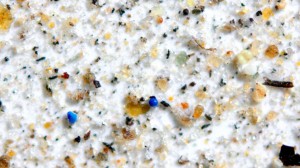Article by Blaine Friedlander, Cornell Chronicle, April 12, 2021
PHOTO — A blue microplastic bead sits on a filter under a microscope, surrounded by dust, minerals and charcoal captured from a park in Idaho. At the 2 o’clock position from the bead is puffy yellow piece of pollen.
Vast watery parcels of plastic – made of soda bottle flotsam and shopping bag jetsam – appear in our oceans as large floating islands. On roadways, plastic is often tossed, broken down into smaller pieces and churned until it is microscopic, at which point it is swept into the atmosphere and travels the world.
By sea or by land, these tiny shards of plastic are more ubiquitous than science had known, according to a new study led by researchers at Cornell and Utah State University. The research was published April 12 in the Proceedings of the National Academy of Science.
Natalie Mahowald, Cornell’s Irving Porter Church Professor in Engineering, and lead author Janice Brahney, Utah State University assistant professor of natural resources, have found that plastics cycle through the oceans and roadways and, if tiny enough, can become microplastic aerosols, which ride the jet stream across continents.
“We found a lot of legacy plastic pollution everywhere we looked; it travels in the atmosphere and it deposits all over the world,” Brahney said. “This plastic is not new from this year. It’s from what we’ve already dumped into the environment over several decades.”
Results from their study, “Constraining the Atmospheric Limb of the Plastic Cycle,” suggest that atmospheric microplastics in the western United States are primarily derived from secondary re-emission sources.
From December 2017 to January 2019, researchers collected atmospheric microplastic data from the western U.S., where 84% of microscopic shards came from road dust – cars and trucks agitating the plastic. About 11% entered the atmosphere from sea spray, and 5% was derived from agricultural soil dust.
As large clusters of refuse plastic merge into pods of plastic islands on the oceans, the oceanic action grinds them into mere micron-size particles, where the winds ferry them into the atmosphere – for as little as an hour, or as long as six days.
In the process of conducting other scientific research, Brahney had discovered bits of microplastic everywhere she went. Marje Prank, a postdoctoral fellow who worked with Mahowald, developed a microplastic transport model to determine the tiny plastics’ origins. Together, they used the model to deduce the sources of these microplastics.
“We did the modeling to find out the sources, not knowing what the sources might be,” said Mahowald, a fellow at the Cornell Atkinson Center for Sustainability. “It’s amazing that this much plastic is in the atmosphere at that level, and unfortunately accumulating in the oceans and on land and just recirculating and moving everywhere, including remote places.
“Using our best estimate of plastic sources and modeled transport pathways, most continents are net importers of microplastics from the marine environment,” she said. “This underscores the cumulative role of legacy pollution in the atmospheric burden of plastic.”
Microplastics are landing and accumulating in all sorts of places, Mahowald said. “It’s not just in the cities or the oceans,” she said. “ We’re finding microplastics in national parks.”
In addition to Mahowald, Brahney and Prank, who is now with the Finnish Meteorological Institute, Helsinki, Finland, the other authors include Gavin Cornwell, Pacific Northwest National Laboratory, Richland, Washington; Zbigniew Klimont, International Institute for Applied Systems Analysis, Laxenburg, Austria; Hitoshi Matsui, Nagoya University, Nagoya, Japan; and Kim Prather, University of California, San Diego.
The research was supported by the National Science Foundation and its National Center for Atmospheric Research Computing facilities; the U.S. Department of Agriculture Forest Service; and Cornell Atkinson.
>>>>>>>>………………………>>>>>>>>……………………>>>>>>>>
See also: “PLASTICS NOW SPIRAL AROUND THE GLOBE — A trio of discoveries about microplastics is just breathtakingly grim for the planet” — April 12, 2021
MICROPLASTICS can be thought of as litter that never, ever goes away. New research into this seemingly invisible pollution shows just how durable they can be as they go from land to sea to air and back again. Every day, microplastics — often smaller than the head of a sewing needle — infiltrate our oceans, our seafood, and even our own bodies. Now, scientists say the problem is more extreme than previously realized.

